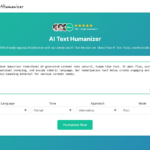We usually think of AI detectors as tools for catching plagiarism or identifying machine-generated content created by others. But what if we turned the lens inward? Could analyzing our own writing with an ai detector portuguese actually help us become better, more engaging human writers? It sounds counterintuitive, but exploring the characteristics these detectors look for might offer surprising insights into making our Portuguese prose more lively, natural, and impactful.
Think about what AI detectors often flag: predictability, uniformity in sentence structure, lack of variation (low “perplexity” and “burstiness”). While these are hallmarks of some AI text, they can also be signs of dull or underdeveloped human writing. Perhaps your meticulously crafted report, essay, or blog post, while 100% human-written, triggers a slight AI score. Instead of dismissing it, what if you used that feedback? An ai detector portuguese like AI Text Humanizer could become an unusual but potentially powerful self-editing tool, helping you spot passages in your Portuguese writing that sound a bit too… robotic.
This isn’t about suspecting yourself of being an AI! It’s about leveraging the technology’s analytical capabilities for writing improvement. Maybe you’ve fallen into repetitive sentence patterns, overused certain jargon, or smoothed out your unique voice too much in an effort to sound professional. An ai detector portuguese might inadvertently highlight these areas, prompting you to inject more personality and dynamism back into your work.
Contents
Why Might Human Writing Trigger an AI Detector?
Several factors in purely human writing could occasionally nudge the needle on an ai detector portuguese:
- Over-Editing: Sometimes, in striving for perfect grammar and clarity, we edit the life out of our writing, removing unique phrasings or natural conversational elements.
- Adhering Too Rigidly to Formulas: Academic or technical writing often follows strict structures. While necessary, this can sometimes lead to predictable sentence patterns that mimic AI’s statistical optimization.
- Simplistic Language: If the vocabulary is very basic and sentence structures are consistently simple, it might lack the complexity (perplexity) typical of more engaging human text.
- Lack of Personal Voice: Writing that avoids personal anecdotes, opinions (where appropriate), or unique stylistic flourishes can sometimes feel impersonal or generic, traits occasionally associated with AI.
- Language Learner Patterns: Non-native speakers learning Portuguese might initially rely on more standard, textbook sentence structures that AI models also tend to produce, potentially triggering a detector.
Recognizing these possibilities allows us to use the feedback from an ai detector portuguese constructively. A slight AI score isn’t an accusation; it’s a potential invitation to revise for greater impact.
Using AI Detection Insights for Better Portuguese Writing
Here’s how you could approach using a tool for self-improvement:
- Check Your Drafts: Run your completed Portuguese drafts through the detector. Don’t panic if it flags something!
- Analyze Flagged Sections: Look closely at the parts identified as potentially AI-like. Ask yourself:
- Is the sentence structure very repetitive here? (Low Burstiness)
- Am I using common, predictable words or phrases too much? (Low Perplexity)
- Does this section sound impersonal or lack my unique perspective?
- Could I vary the sentence length more? Add a shorter, punchier sentence? Or a more complex one?
- Experiment with Revisions: Try rewriting the flagged sections. Inject more varied vocabulary (use a Portuguese thesaurus!). Combine simple sentences or break up overly long ones. Add a rhetorical question, a brief anecdote, or a stronger concluding thought. Use transition words that feel more natural to your style.
- Re-Check (Optional): See if your revisions change the detector’s assessment. The goal isn’t necessarily a “0% AI” score, but to use the tool’s analysis to make conscious stylistic choices.
- Focus on Your Voice: The ultimate aim is to make your writing sound more like you – authentic, engaging, and human. The ai detector portuguese is just one potential mirror reflecting aspects of your style.
Imagine Sofia, a university student in Coimbra, writing an important essay. She feels it’s technically correct but a bit dry. She runs it through an ai detector portuguese. It flags a couple of paragraphs where she relied heavily on standard academic phrasing. This prompts her to reword those sections, incorporating stronger verbs and varying her sentence beginnings, making the argument more compelling and distinctly hers. She used the detector not to check for AI, but to check against sounding like it.
A Tool for Language Learners
This approach can be particularly useful for those learning Portuguese. As learners progress, they often move from basic sentence structures to more complex and idiomatic expressions.
- Identifying Over-Reliance on Standard Forms: An ai detector portuguese might flag text that heavily uses basic grammar patterns taught early on. This could signal an opportunity to incorporate more advanced Portuguese constructions.
- Encouraging Natural Phrasing: By seeing which parts sound potentially “robotic,” learners can focus on finding more natural language equivalents used by native speakers.
- Building Confidence: Successfully revising text to sound more human and less like predictable output can be a confidence booster in the language learning journey.
It’s about using the detector’s sensitivity to patterns as a guide towards more native-like fluency and expressiveness in Portuguese.
Finding the Balance: Authenticity vs. Over-Correction
The key is moderation. Don’t become obsessed with tricking the detector or making your writing artificially quirky. Clarity and effective communication are still paramount. The goal is not to eliminate predictability entirely (some level is needed for coherence) but to ensure your writing has enough variation, personality, and natural language flow to engage your reader.
Use the ai detector portuguese as an occasional diagnostic tool, one data point among others (like feedback from human readers, your own judgment, spell checkers, grammar tools). If it consistently flags your writing, it might indicate stylistic areas worth exploring. If it rarely flags your work, great! It simply confirms your authentic voice is shining through.
Embracing Human Imperfection
Perhaps the most significant benefit of this unconventional use is embracing what makes human writing unique. Our occasional quirks, slight inconsistencies, unexpected word choices, and personal touches are not flaws; they are features that distinguish us from machines.
By using an ai detector portuguese to become more aware of when our writing might be leaning too heavily towards predictable patterns, we can consciously choose to lean back into the richness and variability of human expression. It’s a way to use technology designed to spot machines to, ironically, help us sound more genuinely human.
So, the next time you finish writing something important in Portuguese, consider running it through AI Text Humanizer. Not because you suspect AI, but because you want to ensure your unique human voice is coming through loud and clear, engaging your readers with the authenticity that only genuine human expression can provide. It’s a novel path to writing improvement, using AI’s analytical power to refine our own craft.


